2021 Civil War Travelogues — BGES Shiloh
Welcome to my 2021 travelogue pages. This is my report of the Blue and Gray Education Society tour of the battle of Shiloh, my 19th outing with BGES. It’s the first Civil War excursion I’ve taken since the COVID-19 pandemic hit. Even though I have been to Shiloh three times previously, I signed up for three reasons: (1) the tour historian, Greg Mertz, wrote a book on the battle, Attack at Daylight and Whip Them: The Battle of Shiloh, April 6-7, 1862 (Emerging Civil War Series), for which I did the maps and I wanted to see how well they worked; (2) the tour was advertised as two days on the April 6 battle and one on April 7 (and none on Corinth), which promised to be more comprehensive, and; (3) I just had to get back on the road again after a year of government lockdowns. To see the entire list of my 2021 trips, go here.
| Here is a reminder about the reason I write these pages the way I do. They record my experiences and impressions of Civil War trips primarily for my future use. Thus, they sometimes make assumptions about things I already know and focus on insights that I receive. They are not general-purpose descriptions for people unfamiliar with the Civil War, although I sometimes link to various Wikipedia articles throughout. Apologies about the quality of interior photographs—I don't take fancy cameras with big flashes to these events. If you would like to be notified of new travelogues, connect to me via Facebook. |
Wednesday, May 12
I took an early morning United Airlines flight to Memphis through Denver. Everyone masked throughout the flight and terminals. I was concerned about my rental car from Avis because there have been gas shortages on the East Coast, but there was no problem other than the more-than-$100/day rates that have been jacked up since the pandemic started lifting. I drove about 100 miles on the very rural Tennessee route 57, which I chose because it had a number of historic towns on it that I recognize from my civil war mapping. But it turned out to be quite unmemorable.
Our group hotel was the Lodge at Pickwick Landing in Counce, TN, which is the first time I’ve visited Shiloh without staying in Corinth, MS (or Memphis!). Quite a nice hotel, actually, and just a little bit closer to Shiloh than Corinth was. The area around the hotel is the scenic Pickwick Lake (part of TVA’s treatment of the Tennessee River), a giant smelly paper box factory, and a very sad collection of zero-star tourist infrastructure outside of the state park. The nicest thing about the hotel is that even though there are signs throughout that say masks are required, the front desk people said they actually weren’t, so no one wore them.
Our program started at 7 pm with Greg Mertz giving a short talk about the generals at Shiloh who were getting second chances—Grant, Sherman, Johnston, and Beauregard. We all introduced ourselves and I was surprised to see the first service dog on a BGES tour, a really good boy named—wait for it—Shiloh!
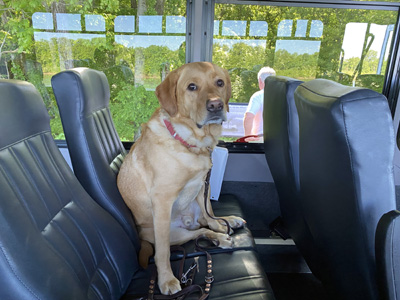
Thursday, May 13
Our travel accommodations are the best in my BGES history! Instead of a cramped van, we had a 15-passenger airport-shuttle-style bus with a center aisle, which was very comfortable and convenient. And since all 13 of us had been vaccinated, we all went unmasked all day, except in the NPS visitor center and bookstore, where the Feds require subservience. Our host/driver was Burford (don’t call him Buford!) Smith, who did an excellent job on driving and arranging lunches. I missed my old friend Len Riedel, but I was told that the BGES board has him physically chained up back in Virginia.
Today was supposed to cover the April 6 battle on the western half of the battlefield, but we dawdled a bit, spending time in the visitor center and cemetery, and we ended up only covering the morning action on the western side. We saw the 45-minute battle video, which is actually quite good. I wondered where the reenactors got all their XXL-sized uniforms. :-)
We wandered through the national cemetery and talked about a few of the interred. There was a poignant collection of Wisconsin color bearers who all died together. A grave of a drummer boy brought up a discussion of Johnnie Clem, the “Shiloh Drummer Boy,” who might not have actually served here. He was later a captain in the Signal Corps, which was exactly what I was 45 years ago. We also talked about changes to the river and Pittsburg Landing.
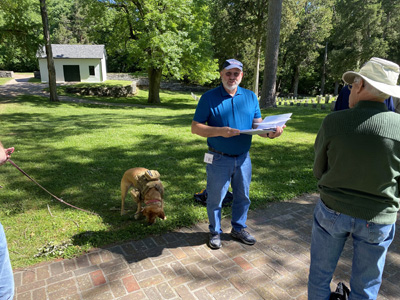


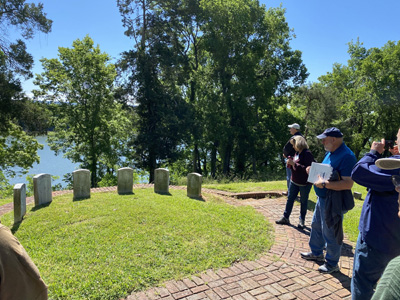

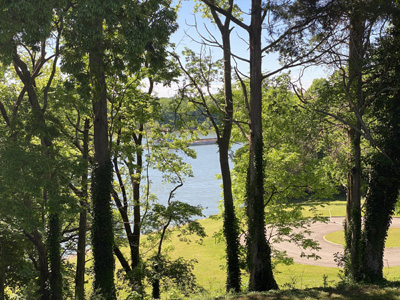
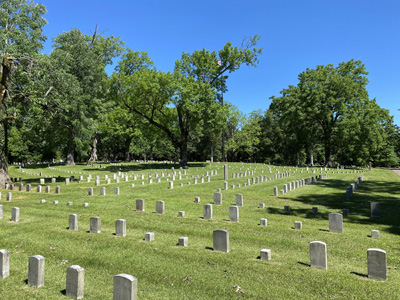
Our first stop was at Albert Sidney Johnston’s “last bivouac,” southwest on the Corinth Road, an empty lot with a Civil War Trails sign. We talked about Johnston’s plans for the battle and how Beauregard messed them up with his altered order of battle. Next was Rea Field. We saw the brand-new Mississippi state monument and explored the camp area of the 53rd Ohio, where it was attacked by the 6th Mississippi (who suffered devastating losses). We walked over to one of the five Confederate mass graves that have been preserved, which presumably contained some of those same Mississippians. We walked down across the East Branch of Shiloh Branch to continue with Cleburne’s attack against Sherman’s division.
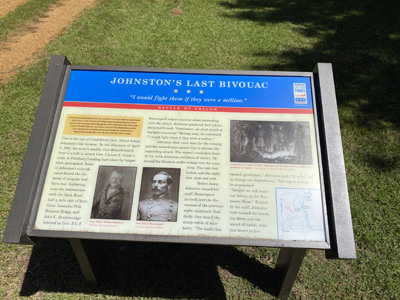
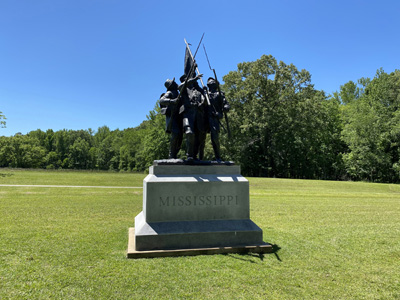

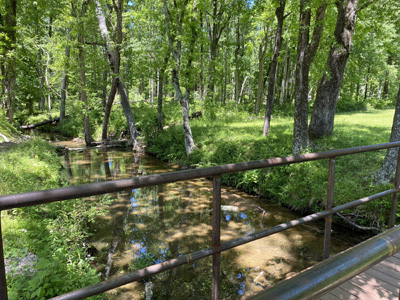
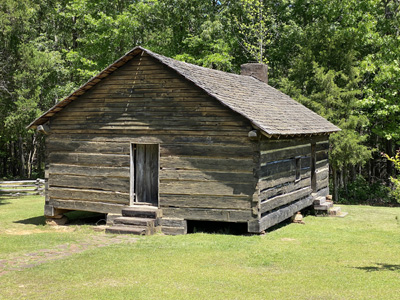
Lunch was good takeout barbecue from a local restaurant, served up in a large picnic pavilion at Sowell Field. Luckily the weather today was superb and eating outside was very pleasant. We returned to attacks on Sherman, visiting Buckland’s brigade west of Shiloh Church, including stops at the 70th Ohio, 48th Ohio, and Barrett’s battery.
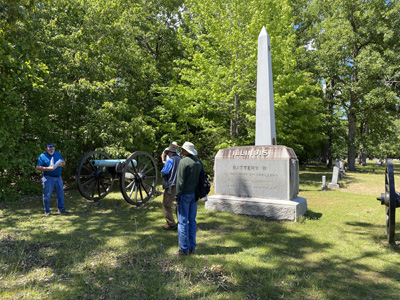
At Seay Field, we started on the attacks against Prentiss’s division. We walked to Fraley Field to see the actual start of the battle, then the camp of Peabody’s brigade, where we discussed all the controversies with Union commanders not paying attention to junior commanders on the front line. We concluded at Peter Spain’s Field to examine the attacks against Miller’s brigade. By this time it was almost 5 pm and everyone was pooped, even though there was still a full afternoon of battle to visit on the western half of the field, so Greg has some re-planning to do for tomorrow.

Dinner was on our own and there are really slim pickin's in this area, so I joined a group at the hotel restaurant (as I did Wednesday as well). Average casual fare at reasonable prices, although the understaffed service department made the evening a slow affair. In a milestone, the CDC announced today that vaccinated people did not need to wear masks outside or in most inside environments. From the trip so far, it looks like Tennessee has been ahead of the Feds on this.
Friday, May 14
We resumed our look at the western side of the battle, starting at Barnes Field, discussing how Albert Sidney Johnston needed to send his attackers farther east than he initially planned. At the Crossroads, we saw the Illinois monument and discussed McClernand’s defensive line. At Duncan Field we took a orientation stop, seeing the start of the line of Ruggles’s Battery. At Woolf Field we saw how Dresser’s Battery protected the retreat of McClernand’s line. And we looked at the Sherman—McClernand counterattack. We advanced farther into the woods to see the Confederate attack on McDowell’s counterattack.
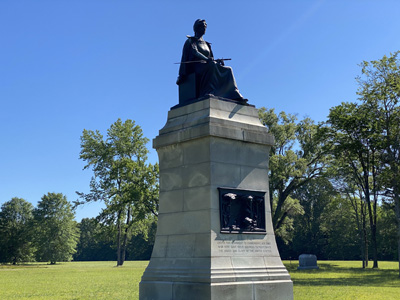
We walked much of the Sunken Road, starting in the center, where it crossed the Eastern Corinth Road, looking at the defenses against the five Confederate attacks. Then another picnic lunch, this time yummy fried chicken. From there we drove to Sarah Bell’s farm. Her Peach Orchard is mostly gone, although there are a few seedlings recently planted. In her cotton field we discussed Hurlbut’s defense.

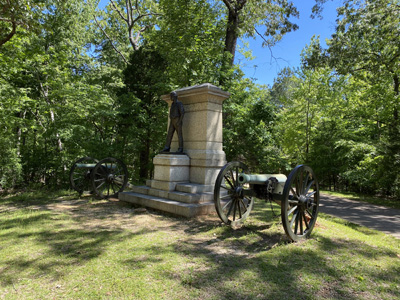


Having completed all of the western side and most of the center, we pivoted east. In Larkin Bell’s Field, we looked at the Johnston/Breckinridge attacks against the three regiments of Stuart’s brigade (Sherman’s division, but separated out to the southeastern position). These three took advantage of the terrain to hold up the Confederate advance quite a bit. From there we went to Albert Sidney Johnston’s mortuary monument. Greg recounted the famous events of Johnston’s wounding and death nearby, prompting a lot of medical speculation from the peanut gallery.
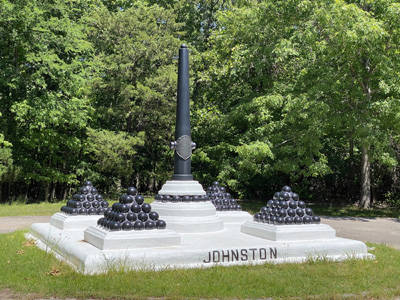
We stopped at the Missouri monument and didn’t say much here, but we could see a monument across the road in Wicker Field to John Wesley Powell’s battery, and Greg told us about his wounding and subsequent career as an explorer of the Grand Canyon, first to travel the Colorado River despite lacking his right arm. We drove a ways to the United Daughters of the Confederacy monument and walked maybe a hundred feet into the woods behind to see the spot where Benjamin Prentiss surrendered himself and 2,200 men from the Hornet’s Nest.
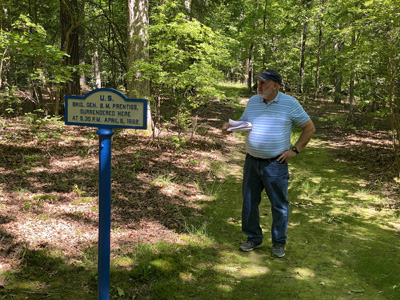
We concluded with “Grant’s Last Line,” just south of the visitor center. There were a few interesting batteries here, including Madison’s, which had some large 24-pounder siege guns, and Silversparre’s, which arrived on the battlefield with four 20-lb Parrotts, but without horses or any trained men; Grant’s chief of staff showed them how to operate the guns while the battle was in progress. There was also a line of large monuments to units that were actually absent from the battle—like modern participation trophies.
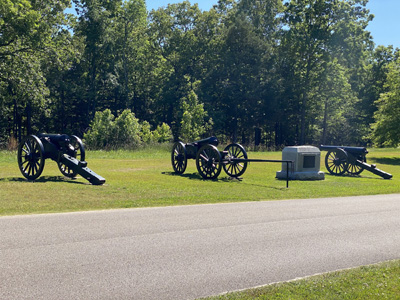
We concluded at Grant’s headquarters in the cemetery, discussing how he reacted to the first day’s battle and the opinions of most of his officers that the army should retreat. On the way out, we drove down into Dill Branch ravine and saw the very difficult terrain the Confederates attempted to assault.
So my concerns about time management did not come to pass, as we got everything we needed about April 6 done in the two days. Kudos to Greg. A number of us went to dinner at a little barbecue restaurant, R&B’s, about a mile from the hotel. Quite good (and very inexpensive by California standards)!
Saturday, May 15
I was impressed enough with R&B that I returned for breakfast. It was really crowded, apparently with a load of weekend golfers. I had a really yummy breakfast burrito, which was about $5, a super bargain. Today the tour subject is mostly April 7, but we had some preliminary items to deal with.
We drove across the Pickwick Dam to reach Savannah, where we stopped outside the Cherry mansion, which was US Grant’s headquarters as well as the place W.H.L. Wallace was taken to die from his mortal wound. (C.F. Smith and Don Carlos Buell also stayed there briefly.) The house has a great view of the Tennessee River. It is privately owned, so we saw only the exterior. Next we took a bridge across the river to Crump, TN, and drove to a seafood restaurant that seems to be close to the location of Crump’s Landing, where Grant met with Lew Wallace on the morning of April 6. We spent some time telling the tale of Wallace’s misadventures. Greg opined that the popular opinion that Wallace was lost is not correct—he knew where he was, but misinterpreted his orders. Shiloh the dog had a good time at this stop, expressing interest in a Confederate cat skulking around.
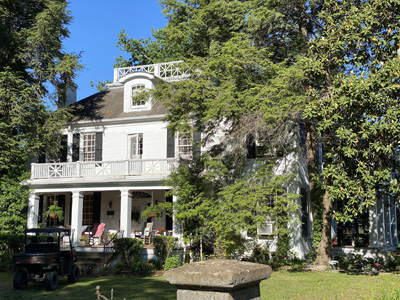
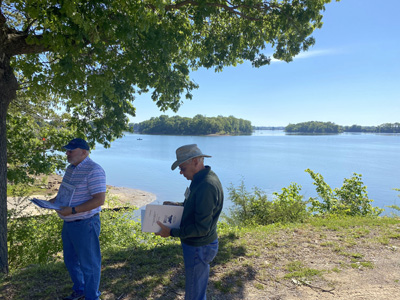
Back on the battlefield, we stopped at Perry Field, at the right flank of Sherman’s line, to start the April 7 discussion. As with the previous days, we are moving geographically rather than chronologically, which I think is a lot easier to grasp. Grant had no detailed plan for his massive counterattack, other than a goal to retake the Union camps. There has been a disagreement between the Army of the Tennessee and the Army of the Ohio about who actually started the firing the second day, but Greg sides with the artillery attached to Wallace. His force artillery-dueled for an hour and then took two hours to cross Tilghman Branch and flush out a lone Confederate brigade, Pond’s. He has received some criticism for a series of turning movements that impelled Confederate withdrawals at a low casualty count, but that seems like a good thing to me.
We drove back to the Last Line area for a discussion of the various options the Confederates might have had, and I don’t think our group established any consensus. At Jones Field, the Confederates attacked the oncoming Union movement, but Wallace again outflanked them and a general withdrawal began. Many of the Confederate attacks in this area were merely distractions to allow their line to move back in an orderly manner.
At Water Oaks Pond we looked at McCook’s attacks, including the 32nd Indiana under August Willich, and the Woods Brigade Confederate attack. We walked to the Shiloh Church cemetery and examined the CS line that held from noon to 2 pm. Another picnic lunch, this time a delicious club sandwich. Burford has done an outstanding job on catering this week.
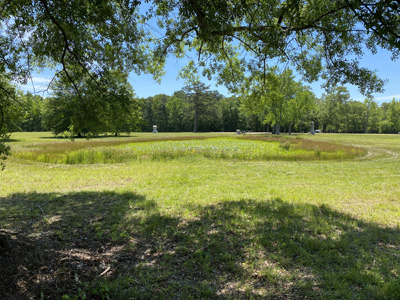
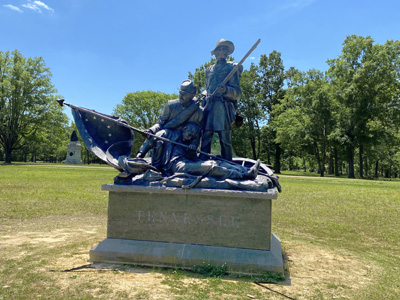
In Davis’s Wheatfield, we looked at the attacks on Crittenden’s division by Breckinridge and Hardee. Greg recounted the death of Samuel Todd, Abraham Lincoln’s brother-in-law, and told a tale of the Terrill brothers, who each became generals, but in the opposing armies. In Sarah Bell’s Old Cotton Field, we discussed the attacks by the 2nd Texas of Moore’s Brigade, and the confusion resulting from the mixed up units in the line.
At the Bloody Pond, we saw how Chalmers counterattacks Ammen’s brigade and how Terrill’s battery was supported by the 6th Ohio. We concluded our battlefield visit at the UDC monument, where we wrapped up the battle and its aftermath. There was an inconclusive discussion about whether Albert Sidney Johnston’s death really mattered to the battle’s outcome. (I said no.) On the way back to the hotel, we stopped at the site of the April 8 battle of Falling Timbers, which is simply an open flat farm field today. Nathan Bedford Forrest clashed with a reconnaissance in force led by Sherman, and he got wounded, but there is little more to say about it.
One observation prompted by thoughts of the UDC: there seem to be no current problems retaining Confederate monuments on the Shiloh battlefield, but I do not recall seeing any Confederate flags.
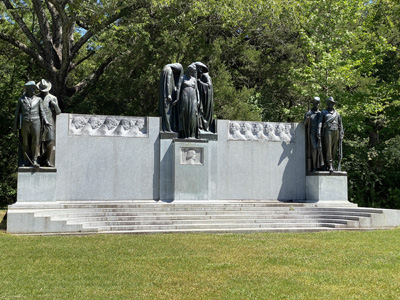

I drove two hours back to Memphis and checked into a hotel, the Marriott Courtyard. To my (minor) dismay, I realized that this is the same hotel I denigrated in my 2013 Vicksburg Campaign trip report. Sigh. At least it was a short stay, about 10 hours.
Sunday, May 16
I returned home on an early morning flight via Houston. This was an excellent brief trip. It was arguably my best visit to Shiloh. Greg Metz did a great job, the logistics were flawless, and the weather was superb! I am looking forward to more BGES action this year.